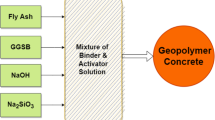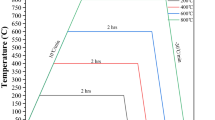Abstract
In the present work, total specific pore volume of inorganic polymers (geopolymers) made from seeded fly ash and rice husk–bark ash has been predicted by gene expression programming. To build the model, training and testing using experimental results from 120 specimens were conducted. The values for input layers were the percentage of fine fly ash in the ashes mixture, the percentage of coarse fly ash in the ashes mixture, the percentage of fine rice husk–bark ash in the ashes mixture, the percentage of coarse rice husk–bark ash in the ashes mixture, the temperature of curing, and the time of water curing. According to the input parameters, in the gene expression programming models, the pore volume of each specimen was predicted. The training and testing results in the gene expression programming models have shown a strong potential for predicting the total specific pore volume of the geopolymer specimens.





Similar content being viewed by others
Explore related subjects
Discover the latest articles, news and stories from top researchers in related subjects.Change history
04 July 2020
The Editor-in-Chief has retracted this article [1] because it significantly overlaps with a large number of articles that were under consideration at the same time, including [2, 3] and previously published articles, including [4���6]. Additionally, the article shows evidence of peer review manipulation. The author has not responded to any correspondence regarding this retraction.
References
Davidovits J (1991) Inorganic polymeric new materials. J Therm Anal Calor 37:1633–1656
Barbosa VFF, MacKenzie KJD (2003) Synthesis and thermal behavior of potassium sialate geopolymers. Mater Lett 57:1477–1482
Duxson P, Provis JL, Lukey GC, Mallicoat SW, Kriven WM, Deventer JSJ (2005) Understanding the relationship between geopolymer composition, microstructure and mechanical properties. Colloids Surf 269:47–58
Duxson P, Fernandez-Jimenez A, Provis JL, Lukey GC, Palomo A, vanDeventer JSJ (2007) Geopolymer technology: the current state of the art. J Mater Sci 42:2917–2933
Panagiotopoulou Ch, Kontori E, Perraki Th, Kakali G (2007) Dissolution of aluminosilicate minerals and by-products in alkaline media. J Mater Sci 42:2967–2973
Milani AA, Nazari A (2012) Modeling ductile-to-brittle transition temperature of functionally graded steels by gene expression programming. Int J Damage Mech 21(4):465–492
Nazari A, Khalaj G, Didehvar N (2012) Computational investigations of the impact resistance of aluminum-epoxy laminated composites. Int J Damage Mech 21(5):623–646
Cottrell GA, Kemp R, Bhadeshia HKDH, Odette GR, Yamamoto T (2007) Neural network analysis of Charpy transition temperature of irradiated low-activation martensitic steels. J Nucl Mater 367–370:603–609
Nazari A, Famil Rohani A (2012) Alkali-activated geopolymer produced by seeded fly ash and rice husk bark ash. Adv Cement Res. http://dx.doi.org/10.1680/adcr.2012.24.1.1
Koza JR (1992) Genetic programming: on the programming of computers by means of natural selection. MIT Press, Cambridge
Rumelhart DE, Hinton GE, William RJ (1986) Learning internal representation by error propagation. In: Rumelhart DE, McClelland JL (eds) Proceeding parallel distributed processing foundation, vol 1. MIT Press, Cambridge
Liu SW, Huang JH, Sung JC, Lee CC (2002) Detection of cracks using neural networks and computational mechanics. Comput Meth Appl Mech Eng 191(25–26):2831–2845
Anderson JA (1983) Cognitive and psychological computation with neural models. IEEE Trans Syst Man Cybern 79:2554–2558 V.SMC-13
Hopfield JJ (1982) Neural networks and physical systems with emergent collective computational abilities. Proc Nat Acad Sci 79:2554–2558
Cevik A, Sonebi M (2009) Genetic programming based formulation for fresh and hardened properties of self-compacting concrete containing pulverised fuel ash. Constr Build Mater 23(7):2614–2622
Topcu IB, Sarıdemir M (2008) Prediction of compressive strength of concrete containing fly ash using artificial neural network and fuzzy logic. Comp Mater Sci 41(3):305–311
Author information
Authors and Affiliations
Corresponding author
Additional information
The Editor-in-Chief has retracted this article because it significantly overlaps with a large number of articles that were under consideration at the same time, including and previously published articles, including (see retraction note for details). Additionally, the article shows evidence of peer review manipulation. The author has not responded to any correspondence regarding this retraction.
About this article
Cite this article
Nazari, A. RETRACTED ARTICLE: Predicting the total specific pore volume of geopolymers produced from waste ashes by gene expression programming. Neural Comput & Applic 31 (Suppl 2), 751–757 (2019). https://doi.org/10.1007/s00521-012-1135-7
Received:
Accepted:
Published:
Issue Date:
DOI: https://doi.org/10.1007/s00521-012-1135-7




